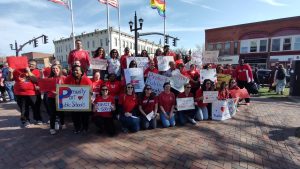Oberlin Students Seek Role in Occupy Movement
October 14, 2011
Almost one month after the Occupy Wall Street protest began in New York City, roughly 350 cities across the nation from the Northeast to the West Coast to the South have been occupied by protesters seeking a new economic justice for Americans, operating under the slogan, “We are the 99 percent.”
“I think the goal of the movement is to change the consciousness of our country and to have at least some people saying the unfortunate, uncomfortable truths and the muffled truth: that there is class warfare going on in this country and it is initiated by the rich and not the poor, no matter what Mitt Romney has to say,” said College junior Adam Wadley.
The Occupy Wall Street movement has no hierarchical structure. There is no one person or organization leading the movement. Alternative news source Adbusters put out the call in the summer of 2011 for 20,000 people to show up on Wall Street on the morning of Sept. 17 to directly address and protest the bankers and the 1 percent of the nation that holds the vast majority of this country’s wealth.
A contingent of 25 Oberlin students arrived in New York City on the night of Sept. 16 to participate in the protest. College senior Sam Williams says that the police had already barricaded Wall Street in anticipation of the protest. The morning of Sept. 17, 1,000 protestors gathered at Zuccotti Park for the first day of a protest that has now grown vastly in size and in ideology. The demands of the movement were at first unclear, but a series of smaller and larger general assemblies were held to determine what the demands of the protest would be.
“In the smaller general assemblies I was pretty happy to see that whatever situation they were in, the Oberlin students took a significant leadership role in a really positive way, which is a source of pride for me,” said Williams.
Wadley says that most of the Oberlin students who went to the protest are involved in OSCA on campus, so they were already familiar with the process of modified consensus and could easily fulfill facilitation roles in group discussions. Since the students’ return from Wall Street, they have been attempting to organize a radical student movement on campus. Wadley says that although OSCA is helpful in being able to directly participate in facilitating the protests, he hopes to make the student group on campus more representative.
“There’s a lot of work that needs to be done first of all reaching out to a diverse range of students. I feel like the people who have been showing up to meetings are mostly co-opers, mostly white students, a lot of white males like myself with political ideas who come to rant sometimes,” said Wadley.
The Occupy Together movement is swiftly making its way to the Oberlin community. On Thursday, Oct. 13, at 5 p.m. there was an Oberlin in Solidarity gathering in Tappan Square that addressed the current state of the movement on Wall Street, in cities across the country and in Cleveland.
“Every local occupation has something that seems the most pertinent because of the geographic location,” said Williams. “In New York, it was really about bringing attention to specifically which banks had a role in the 2008 crisis and who on Wall Street could be directly pointed to as players in that system that led the few to keep getting paid the same salaries that they always had been getting paid and then seeing mass layoffs and the beginning of these foreclosures. It looks a little different in Cleveland because that’s where the Fed is, so obviously a lot of the issues are surrounding the Fed’s role in the 2008 collapse of everything. It’s really about collective bargaining and moratoriums on foreclosures.”
The occupation of Cleveland started Oct. 6 and is taking place in Willard Park on the corner of 9th street and Lakeside Ave. The Occupy Cleveland movement is a nonviolent, lawful movement operating under a specific set of eight demands and striving to work cooperatively with the police. Several Cleveland City Council members endorsed the Occupy Cleveland movement, officially giving their support at the council meeting on Wednesday.
Williams and Wadley are attempting to get more Oberlin students, as well as professors, faculty, CDS workers, maintenance workers and Oberlin community members, collectively involved in the movement. According to Williams, the main issue they have encountered is transportation. While the College provided vans to use for the students to attend Occupy Wall Street in New York City, Williams says it has become “abundantly clear that we would not get funding again for transportation.” However, she hopes that formulating a College-community partnership for these protests will result in some sort of carpooling system.
On Thursday, the Student Labor Action Coalition, the Oberlin Peace Activist League, the Oberlin Democrats and the Politics department sponsored a National Economic Justice Teach-in in order to further educate Oberlin students on the economic issues central to the Occupy Wall Street movement.
“You don’t have a right to make trillions of dollars. The goal is just to spread that awareness that people are a part of this lower group, this 99 percent, and that we can only attain justice together,” Wadley said.


















